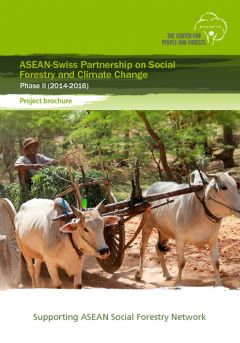Zambia National Strategy to Reduce Emissions from Deforestation and Forest Degradation (REDD+).
This document lays down the Zambia National Strategy to Reduce Emissions from Deforestation and Forest Degradation (REDD+). Zambia has developed this strategic document under the REDD+ mechanism. Its vision is to realize a prosperous climate change resilient economy by 2030, anchored upon sustainable management and utilization of Zambia’s natural resources towards improved livelihoods.
Colombia Siembra.
Colombia Siembra es la estrategia del Ministerio de Agricultura y Desarrollo Rural (MADR) para aprovechar el potencial de desarrollo agropecuario que tiene el país. El documento establece la meta de sembrar un millón de hectáreas adicionales en el país entre 2015 y 2018, con un enfoque en el incremento de la productividad que garantice la oferta constante y la mejora de la calidad de los productos, y fomento de las exportaciones agropecuarias.
Agenda_Inception and Training Workshop 23 - 25 February 2015 Antalya, Turkey
An Assessment of the Economics of Land Degradation for Improved Land Management in Central Asia
Inception and Training Workshop
23 - 25 February 2015
Antalya, Turkey
Social Forestry and Climate Change in ASEAN: How Can We Address Deforestation and Meet National Targets for Social Forestry
RECOFTC' s report 'The current status of social forestry in climate change adaptation and mitigation in the ASEAN Region' offers insights on national forestry data and information on forest cover and areas managed by local people for eight ASEAN Countries (Cambodia, Indonesia, lao PDR, Malaysia, Myanmar, Philippines, Thailand and Viet Nam. This infographic provides a snapshot of what is presented in the report.
ASEAN-Swiss Partnership on Social Forestry and Climate Change Phase II (2014-2016)
Since 2009, the Government of Switzerland and RECOFTC have partnered with ASEAN through the Swiss Agency for Development and Cooperation (SDC)’s support to the ASEAN Social Forestry Network (ASFN) and the ASEAN-Swiss Partnership on Social Forestry and Climate Change (ASFCC). This is a brochure describing the RECOFTC activities under the ASFCC Phase II (2014-2016).
Forces of change shaping the future commercial real estate market in the Helsinki Metropolitan Area in Finland
The built environment as a part of society is facing fast and constant changes occurring in the surrounding environment. This is a challenging situation for real estates because their character does not inherently support fast changes and constant development. Nevertheless there are many reasons why it is essential that also commercial real estates are able to answer to development goals set to them by different market actors. This can be achieved by analyzing forces of change affecting the market at this moment.
Bus stop, property price and land value tax: A multilevel hedonic analysis with quantile calibration
Based on a multilevel and quantile hedonic analysis regarding the local public bus system and the prices of residential properties in Cardiff, Wales, we find strong evidence to support two research hypotheses: (a) the number of bus stops within walking distance (300–1500m) to a property is positively associated with the property's observed sale price, and (b) properties of higher market prices, compared with their cheaper counterparts, tend to benefit more from spatial proximity to the bus stop locations.
Co-firing in Coal Power Plants and its Impact on Biomass Feedstock Availability
Several states have a renewable portfolio standard (RPS) and allow for biomass co-firing to meet the RPS requirements. In addition, a federal renewable fuel standard (RFS) mandates an increase in cellulosic ethanol production over the next decade. This paper quantifies the effects on local biomass supply and demand of different co-firing policies imposed on 398 existing coal-fired power plants. Our model indicates which counties are most likely to be able to sustain cellulosic ethanol plants in addition to co-firing electric utilities.
Policy Drivers of Land Mobility in Irish Agriculture
This paper compares financial returns deriving from a range of agricultural land use options in order to examine the effectiveness of agricultural land mobility policies in Ireland. Irish agriculture is characterised by a lack of land mobility despite a number of policy initiatives designed to address to problem, most notably tax exemptions on income derived from the long-term leasing of land.
GLOBAL CHANGES IN HARVESTED AREA IN CORN, SUGARCANE AND OILSEEDS: THE ECONOMETRIC ESTIMATION OF THE ROLE OF BIOFUEL PRODUCTION, FOREIGN DIRECT INVESTMENT, INCOME AND POPULATION GROWTH
Global harvested area of crops has expanded (+8%) in the period of 2004-2011. Nevertheless, some crops such as maize, sugarcane, and oilseeds expanded area more rapidly than the average rise. Although, some economists attribute this effect to biofuel production, economy also has encouraged expansion in cropland to satisfy food demand. This paper analyzes the impact that biofuel production and economic variables has had on harvested area for corn, sugar, and oilseeds.
Understanding determinants of farmers’ investments in, and impacts of, soil and water conservation in Ethiopia: review and synthesis [Abstract only]
Although there has been a considerable effort to reduce soil erosion and improve land productivity in Ethiopia, farmers’ investments in SWC remain limited. There is a long and rich tradition of empirical research that seeks to identify the determinants that affect farmers’ investments in SWC practices. Nevertheless, the results regarding these determinants have been inconsistent and scattered. Moreover, the impacts of different SWC practices have not been reviewed and synthesized.





